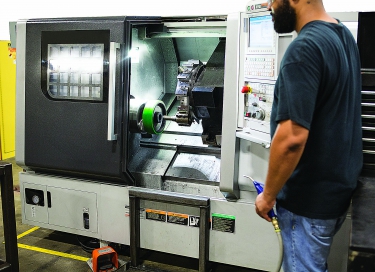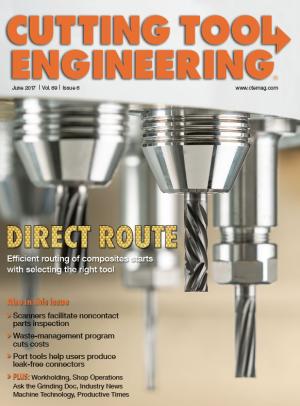Colson Group USA, a manufacturer of casters, wheels and other mobility products, continues to make significant investments to its production and distribution operations while reshoring some manufacturing.
Those investments include adding automation equipment, such as robotic welding cells, at the Oakbrook Terrace, Ill.-headquartered company’s two Michigan manufacturing facilities, in St. Joseph and Albion. “That has greatly improved our quality and our ability to react to our customers’ needs and has opened up new doors for us in regards to how we are looking at our manufacturing capabilities from a global standpoint,” said COO Chris Cummins.
He added that the addition of a laser cutting system enabled the company to reshore manufacturing of the heavy-duty Albion 310 and 410 kingpinless casters from one of Colson’s Asian plants, and the company is moving forward with investments to return more manufacturing to the U.S.

A wheel core is machined on a new CNC lathe at Colson. Image courtesy of Colson Group.
To effectively compete with low-cost-labor countries on even sensitively priced products, Colson leverages the benefits of cold heading, or cold forming, to produce from 4,000 to 5,000 parts per hour without any scrap. “When you have automation and precision machining of that nature, you are not worried about a labor-cost-type issue,” Cummins said. “You are more worried about how many high-quality parts you are making.”
The precision machining also includes the use of CNC lathes and mills to produce wheel cores, for example, and automatic thread rollers and groove cutters to make a variety of fasteners. In addition to steel, Colson CNC-machines nylon billets to produce heavy-duty wheels that are as strong as steel yet don’t damage floors, noted Brad Kish, director of marketing and communications for Colson Group.
To help enable the company’s manufacturing operations to focus on manufacturing and not distribution, Colson Group built a 176,000-sq.-ft. national distribution center in St. Joseph in early 2016. “We’re really proud of our efforts, and it’s continuing to get better every day,” Cummins said about the distribution center. “It came a long way in this very first year.”
Related Glossary Terms
- computer numerical control ( CNC)
computer numerical control ( CNC)
Microprocessor-based controller dedicated to a machine tool that permits the creation or modification of parts. Programmed numerical control activates the machine’s servos and spindle drives and controls the various machining operations. See DNC, direct numerical control; NC, numerical control.
- lathe
lathe
Turning machine capable of sawing, milling, grinding, gear-cutting, drilling, reaming, boring, threading, facing, chamfering, grooving, knurling, spinning, parting, necking, taper-cutting, and cam- and eccentric-cutting, as well as step- and straight-turning. Comes in a variety of forms, ranging from manual to semiautomatic to fully automatic, with major types being engine lathes, turning and contouring lathes, turret lathes and numerical-control lathes. The engine lathe consists of a headstock and spindle, tailstock, bed, carriage (complete with apron) and cross slides. Features include gear- (speed) and feed-selector levers, toolpost, compound rest, lead screw and reversing lead screw, threading dial and rapid-traverse lever. Special lathe types include through-the-spindle, camshaft and crankshaft, brake drum and rotor, spinning and gun-barrel machines. Toolroom and bench lathes are used for precision work; the former for tool-and-die work and similar tasks, the latter for small workpieces (instruments, watches), normally without a power feed. Models are typically designated according to their “swing,” or the largest-diameter workpiece that can be rotated; bed length, or the distance between centers; and horsepower generated. See turning machine.
- precision machining ( precision measurement)
precision machining ( precision measurement)
Machining and measuring to exacting standards. Four basic considerations are: dimensions, or geometrical characteristics such as lengths, angles and diameters of which the sizes are numerically specified; limits, or the maximum and minimum sizes permissible for a specified dimension; tolerances, or the total permissible variations in size; and allowances, or the prescribed differences in dimensions between mating parts.


